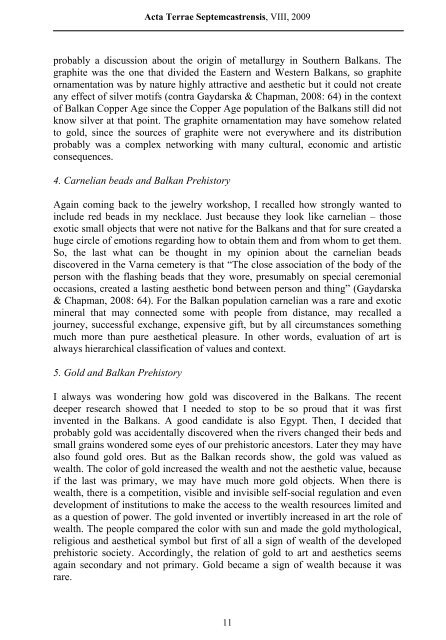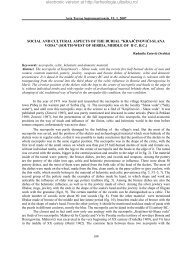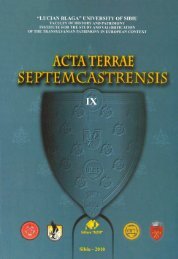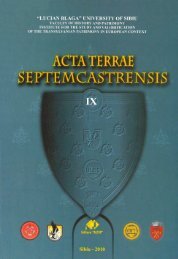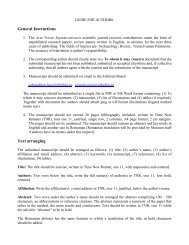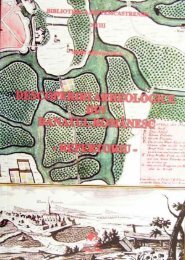acta terrae septemcastrensis viii - Institutul pentru cercetarea Åi ...
acta terrae septemcastrensis viii - Institutul pentru cercetarea Åi ...
acta terrae septemcastrensis viii - Institutul pentru cercetarea Åi ...
You also want an ePaper? Increase the reach of your titles
YUMPU automatically turns print PDFs into web optimized ePapers that Google loves.
Acta Terrae Septemcastrensis, VIII, 2009<br />
probably a discussion about the origin of metallurgy in Southern Balkans. The<br />
graphite was the one that divided the Eastern and Western Balkans, so graphite<br />
ornamentation was by nature highly attractive and aesthetic but it could not create<br />
any effect of silver motifs (contra Gaydarska & Chapman, 2008: 64) in the context<br />
of Balkan Copper Age since the Copper Age population of the Balkans still did not<br />
know silver at that point. The graphite ornamentation may have somehow related<br />
to gold, since the sources of graphite were not everywhere and its distribution<br />
probably was a complex networking with many cultural, economic and artistic<br />
consequences.<br />
4. Carnelian beads and Balkan Prehistory<br />
Again coming back to the jewelry workshop, I recalled how strongly wanted to<br />
include red beads in my necklace. Just because they look like carnelian – those<br />
exotic small objects that were not native for the Balkans and that for sure created a<br />
huge circle of emotions regarding how to obtain them and from whom to get them.<br />
So, the last what can be thought in my opinion about the carnelian beads<br />
discovered in the Varna cemetery is that “The close association of the body of the<br />
person with the flashing beads that they wore, presumably on special ceremonial<br />
occasions, created a lasting aesthetic bond between person and thing” (Gaydarska<br />
& Chapman, 2008: 64). For the Balkan population carnelian was a rare and exotic<br />
mineral that may connected some with people from distance, may recalled a<br />
journey, successful exchange, expensive gift, but by all circumstances something<br />
much more than pure aesthetical pleasure. In other words, evaluation of art is<br />
always hierarchical classification of values and context.<br />
5. Gold and Balkan Prehistory<br />
I always was wondering how gold was discovered in the Balkans. The recent<br />
deeper research showed that I needed to stop to be so proud that it was first<br />
invented in the Balkans. A good candidate is also Egypt. Then, I decided that<br />
probably gold was accidentally discovered when the rivers changed their beds and<br />
small grains wondered some eyes of our prehistoric ancestors. Later they may have<br />
also found gold ores. But as the Balkan records show, the gold was valued as<br />
wealth. The color of gold increased the wealth and not the aesthetic value, because<br />
if the last was primary, we may have much more gold objects. When there is<br />
wealth, there is a competition, visible and invisible self-social regulation and even<br />
development of institutions to make the access to the wealth resources limited and<br />
as a question of power. The gold invented or invertibly increased in art the role of<br />
wealth. The people compared the color with sun and made the gold mythological,<br />
religious and aesthetical symbol but first of all a sign of wealth of the developed<br />
prehistoric society. Accordingly, the relation of gold to art and aesthetics seems<br />
again secondary and not primary. Gold became a sign of wealth because it was<br />
rare.<br />
11


